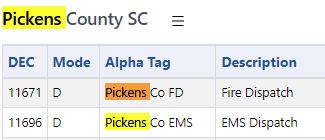@Bgolf , the frequency isn't the department (Sheriff, Fire, etc). When it comes to the trunking aspect, all of the frequencies at a tower site, say the Easley tower that brian listed above, for example, are sort of like a pool. That tower supports all 8 of the listed freqs. For this example, lets say we're talking about County Fire Dispatch.
Frequency pool on Easley tower:
View attachment 164805
County Fire Disp would be your talkgroup. For this, the talkgroup ID is 11671.
View attachment 164804
Lets say we have Users A, B, and C all on the Fire talkgroup.
When user A presses the PTT button, the radio sends a signal to the tower and says I need a frequency for talkgroup 11671. The repeater grants the radio a frequency out of the pool and also sends a signal to every other radio listening on group 11671 to tune to that frequency. Then the radio gives the beep saying you're good to talk. The user speaks their message and de-keys.
Now user B wants to reply. He presses the PTT and the same process happens again. The repeater may or may not give them the same frequency from the pool, but whichever one it grants user B a signal goes out to all radios listening on that talkgroup to tune to that frequency for the duration of the message.
Analog was frequency = talkgroup.
With the digital, it's frequency = frequency, talkgroup = what group is using frequency at this time.
With your scanner (if it supports trunk tracking) it knows that if you are trying to listen to fire that it has to dynamically tune to the frequency given to that talkgroup when someone starts to key their radio. If it doesn't support the trunk tracking and you just listen to the frequencies, you may hear User A call User B but may not necessarily hear the return if the repeater assigns a different frequency.
I hope that helps make it a bit more clear.



